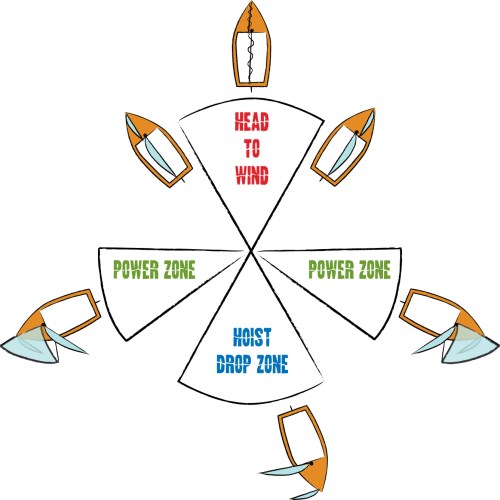Dropping an asymmetric spinnaker
Go To: Sailing - Techniques and Manoevres
Posted on 11 July 2009 17:55
So you successfully hoisted the spinnaker, flew it on a relatively downwind course, and are fast approaching the leeward mark, to head upwind again, so that spinnaker needs to come down, quickly! What do you do?
First of all, consider the side the spinnaker is on – is it on the same side as the chute? If not, it’s going to make it more difficult to drop, so consider putting in a gybe first if your course will allow it – this ideally should be planned before hand. This is known as the preferred side for the drop.

Diagram 1: Hoist/Drop Zone and Power Zone
Next, you should bear away out of the power zone, downwind into the hoist/drop zone (see Diagram 1 above), where the spinnaker depowers. The main sail should fill with wind, and allow it to trim outwards, and blanket the spinnaker, to depower it more.
As the spinnaker loses its wind and its power, you are ready to drop it. Depending on how the boat is rigged, this goes different ways. If it’s a one line launch system, then uncleat the line, and keep clear of the line in the boat. As you drop the spinnaker and pull on the retrieval line (see how to rig an asymmetric spinnaker), the halyard line will shoot through the boat, so make sure you’re not sitting on it – or you can pull on the retrieval line as much as you want, it won’t budge!
Very often you’ll find after several handfuls of rope that it gets a lot harder, as the friction of the sail coming down into the chute starts to take effect – it’s at this point you should start taking handfuls of sail, and pulling the sail into the boat through the chute - once again, make sure you’re not sat on the rope.
To finish, and retrieval the bowsprit into the boat, if you have a one line launching system, then just keep pulling handfuls of sail into the boat, and eventually it’ll pull the pole in too – if you have a two line launching system, then there may well be a line to pull to pull the bowsprit back into its tube/the boat.
As you can see, it’s a lot easier to drop than it is to hoist. The most important things to consider when it comes to the drop is timing, approach (preferred side for drop), and finally, how the boat is set – make sure everything’s uncleated, as a rope isn’t going anywhere if it’s jammed off!
At this point, we can’t stress enough the preferred side – recently we were sailing a Laser Bahia in Turkey, spinnaker flying, and needed to drop. We hadn’t paid enough attention initially to the preferred side, and attempted to drop the spinnaker on the other side. When it’s not on the preferred side for the drop, the retrieval line will be on the inside of the sail, and not particularly efficient. After four attempts at a drop, we had to gybe it, and then it dropped first time, straight into the chute.
Different boats have slightly different approaches to spinnakers; we sailed RS Feva’s single handed in Greece, the one morning with main, jib and spinnaker flying. It was easy to hoist, easy to fly and relatively easy to gybe single handed, even in Force 3-4 winds, however when it came time for the spinnaker drop, it got about a quarter of the way down, then due to a curious design flaw in the spinnaker chute, the spinnaker got snagged on a metal bar that goes over the chute, and wouldn’t go down any further. Cue much waving of arms for the safety boat, before I ran out of water... Always be comfortable and familiar with your boat design before going out on a limb, or as the case is here, a reach...